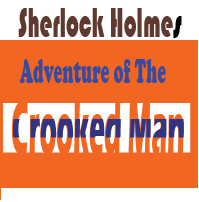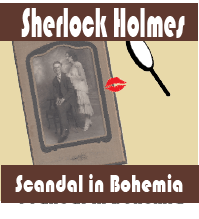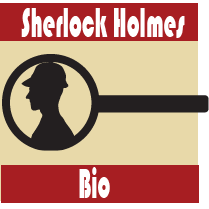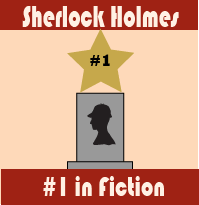Analysis of A Scandal in Bohemia
"A Scandal in Bohemia" analysis uncovers the fact that Doyle and Holmes partnered to commit several literary crimes making this one of the most famous detective tales ever.
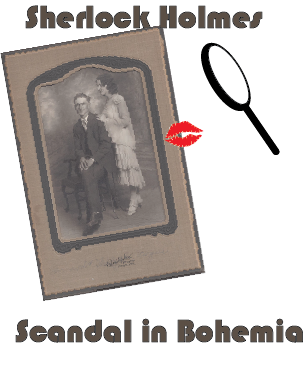
- Analysis of the Plot Structure
- Analysis of the Storyline
- Fictious References
- Holmes and Money
- Fun Facts and Background Information
- Figures of Speech and Literary Techniques
About This Unit Study
The information below is taken from Sherlock Holmes: The Unit Study. Within the unit study, information is presented in short activities without the answers.Pre-Reading Activity
Before reading the story, students were asked to do two things in their reading:- Uncover All the scandals in the story.
- Decide what made Irene Adler one of the most enigmatic characters in the Sherlock series
Analysis of the Plot and Structure
Most Sherlock Holmes short stories follow this plot structure:
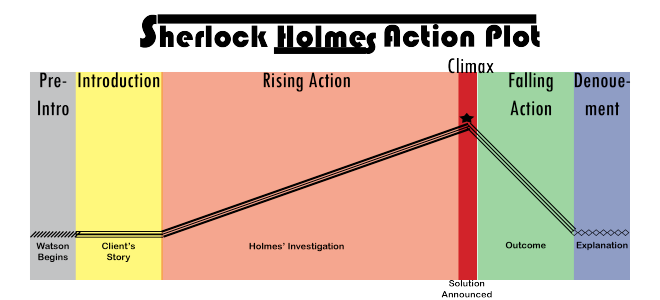
A Scandal in Bohemia follows largely the same structure, with a few differences and unique features.
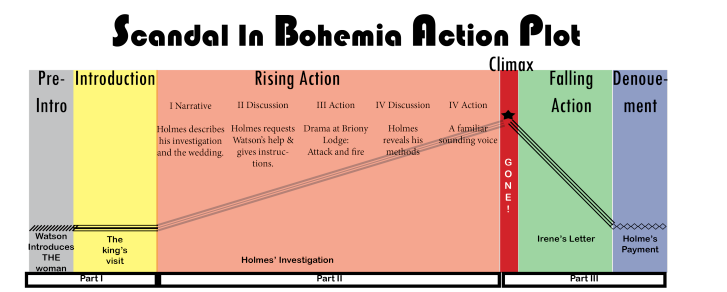
Here are the unique features of A Scandal in Bohemia as one of the Sherlock short stories:
- The Rising action is complex; it consists of five distinct parts. (The last two could arguably be combined into one part.)
- Holme's explanation: Usually Holme's explanation is part of the falling action. Here we are treated to it sooner. He explains his behavior and what he found at Briony Lodge. We still haven't seen his actual attempt to recoup the photo.
- RARE TECHNIQUE: The first part of the rising action is Holme's narrative. This is a very unusual literary technique. See below.
- This is one of the few short stories where Doyle has Part I, Part II, Part III. Possibly this is because it was his first short story and he was transitioning from the novelettes. Possible it is because the Rising Action (which corresponds to Part II) is more complex.
Opening
Of the three types of openings to Sherlock Holmes tales, "Scandal in Bohemia" starts with one of the most dramatic. This, perhaps, is one of the strongest Power Statements used by Watson/Doyle to open a narrative:"To Sherlock Holmes she is always THE woman.
The words catch the attention of modern fans. But imagine their impact for the original hearers, for this was the first short story to appear in print. With eight words the writer announces a complex relationship between literature's foremost bachelor and women. More info on Sherlock's relationship with women.Unique Change in Perspective
We mentioned above that there is another very tricky deviation in literary technique that occured in the first part of the rising action.We have previously discussed how Doyle wrote in the first person-secondary perspective so the reader will see through the eyes of Watson. All the secrets are revealed when Watson finds them out.
Doyle frequently uses a Narrative Technique. This occurs when someone tells the main character a story or event. Most of the time readers watch the action in literature, but with narrative technique they listen to a conversation where the action is described. Usually in Sherlock Holmes tales it is the client that tells the narrative in the introduction. Authors use narrative technique for different reasons. But now, let’s look at Doyle’s trick here.
In the first narrative of the rising action Sherlock tells Watson about the events earlier that day when he followed and took part in the wedding of Irene and Norton. Normally a reader follows the action of the main character, not finds it out when it is described in narrative technique BY the main character TO a secondary character.
You will rarely find in literature where the main character uses narrative technique because usually the reader is watching the main character. It’s almost as if Doyle does a 180 degree turn in literary perspective.
Threats of the king? Blackmail by Irene Adler?
As a literary critic, you may have noticed something about the plot that doesn’t quite fit together. Compare these two opposing statements, one by the king at the beginning of the story and one by Irene at the end:King: (She) threatens to send them (his bride’s family) the photograph. And she will do it. I know that she will do it. You do not know her, but she has a soul of steel.....she has said that she would send it on the day when the betrothal was publicly proclaimed.
AND
Irene: As to the photograph, your client may rest in peace. I love and am loved by a better man than he. The King may do what he will without hindrance from one whom he has cruelly wronged. I keep it only to safeguard myself, and to preserve a weapon which will always secure me from any steps which he might take in the future.Is this a case of blackmail? (demanding money or another action from someone to prevent the blackmailer from releasing damaging information)
Three explanations can be given for this contradiction.
- Doyle left a weak spot in the plot with this contradiction. Sometimes he did get sloppy with details that changed between stories.
- The king was wrong in the first statement above. Perhaps Irene had said something years before that he is afraid of. Perhaps his ego believes she cannot live without him. But she is not really interested in him at all.
- Irene still does care about the king and her statement reflects a sour-grapes attitude. Her unplannned and hurried wedding a few days before the king’s announcement might indicate that her actions were influenced by the king.
Analysis of the Story Line
Scandals In the Story
Victorian England would be shocked! At least we say they would, but apparently they weren't. This was the first of the Sherlock Holmes short stories and the prudy public loved it. (It had been preceeded by two short Sherlock novels so he was not a new character.)So just what were the scandals threaded through this tale of our law-loving detective?
- A romantic affair between an actress and crown prince - (This is the main scandal and source of action. And as modest as the public was, I'm guessing they had a pretty good idea royalty did not live by the same moral standards expected of commoners. Then or now.)
- Cocaine use - A bigger scandal today than in the past. Substance abuse as a whole is present and largely accepted in these stories. (Not completely though; see below.)
- Fake identity - (Today we call that Identity Fraud. Again, royalty excluded.)
- Lying and attempted theft - He calmly asks the king why he doesn't simply lie about the photo or steal it? Is our hero advocating such behavior, or simply inquiring about something everyone knew a king would do?
- Breaking the Law - What! Our heroic law-abiding detective not only breaks the law but asks his humble, trusting, all-good side kick Watson to do the same?
- Disguise - Sherlock fans know he has a knack for disguise. However, some may find particular irony in his disguises here:
- As a pretended groom he took advantage of the "wonderful sympathy and freemasonry among horsey men." (Some Free Masons claim based on this and a few other passages that Sherlock was a Mason.)
- He dressed as a benevolent clergyman in order to rob a woman. (Tsk, tsk, the woman he most cares about, no less.)
- Social class - Is it, or should it be, a scandal that a king cannot marry the woman he loves? Does Doyle embrace social standards or simply accept them? See discussion below.
What Kind of Mystery Is This?
Most detective stories have a classic "Who Dunn It?" question. It's the role of the writer and the detective to discover the culprit.Doyle does use "Who Dunn It?" stories. But he frequently changes things up a bit. This isn't a question of WHO? It's a question of WHERE?
His mission (which he did accept) is to find and return the photograph.
Did he succeed? Sort of.
- He found it. But then she took it and disappeared.
- The king was satisfied. His primary objective of keeping the photo from his new bride's family was achieved. Hail to Holmes!
- But Sherlock was outsmarted. And THAT smarted.
Irene Adler and Sherlock Holmes: The Enigma
To Sherlock Holmes she is always THE woman. I have seldom heard him mention her under any other name. In his eyes she eclipses and predominates the whole of her sex. It was not that he felt any emotion akin to love for Irene Adler. All emotions, and that one in particularly, were abhorrent to his cold, precise, but admirably balanced mind.
Irene Adler can be called the most major minor character in literature. In spite of the fact that she is only in this one story, the character of Irene appears in almost every Sherlock Holmes movie and story written after the canon. She is an enigma to the entire Sherlock series.
What makes Irene so enigmatic?
- In the first sentence he introduces her as THE woman. That gets the reader's attention.
- He then spends a long paragraph talking about how Holmes could never fall in love. That is apparently an important point Doyle set out at the beginning of the series. No reader should be waiting for a heroine's arrival.
- But at the end of that second paragraph, he returned to this new mysterious character with the words “the late Irene Adler, of dubious and questionable memory.“
- More fireworks for the reader. Just who is THIS woman?
- Dubious and questionable memory? Is THAT the kind of woman a hero would fall for?
- Late? She died? How'd she die? What's about to happen here?
- It's not just Holmes affected by her charms. All men were mesmerized by her including the stable hands, Holmes and even His Royal Highness, King of Bohemia. (We'll skip the full name here.)
- In spite of her appeal, all those men seem quite able to get along fine without her. Rather than being broken by the fact that the woman he admires just married another man and fled the country, he simply laughs it off. (AND takes her portrait for payment. See discussion on money below.)
Irene Adler's Description
Here are a few statements that help us form a picture of Irene:Sherlock: She is the daintiest thing under a bonnet on this planet. So say the Serpentine-mews, to a man. (Serpentine mews: the people who live in the mews or backhouses on the fictitious street of Serpentine.)
Sherlock: I only caught a glimpse of her at the moment, but she was a lovely woman, with a face that a man might die for.
Watson: I know that I never felt more heartily ashamed of myself in my life than when I saw the beautiful creature against whom I was conspiring or the grace and kindliness with which she waited on the injured man.
The King of Bohemia: A Foil to Irene
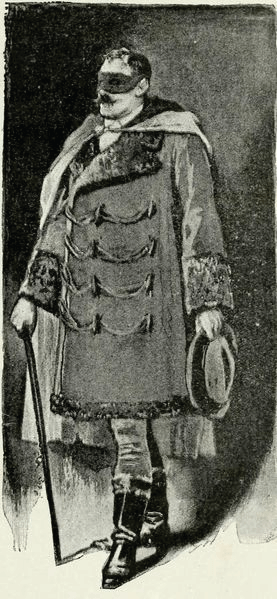 Just what would you think of a person who entered your room and matched these two descriptions:
Just what would you think of a person who entered your room and matched these two descriptions:
A man entered who could hardly have been less than six feet six inches in height, with the chest and limbs of a Hercules. His dress was rich with a richness which would, in England, be looked upon as akin to bad taste. Heavy bands of astrakhan were slashed across the sleeves and fronts of his double-breasted coat, while the deep blue cloak which was thrown over his shoulders was lined with flame-coloured silk and secured at the neck with a brooch which consisted of a single flaming beryl. Boots which extended halfway up his calves, and which were trimmed at the tops with rich brown fur, completed the impression of barbaric opulence which was suggested by his whole appearance. He carried a broad-brimmed hat in his hand, while he wore across the upper part of his face...a black vizard mask.
More about this person:
a straight chin suggestive of resolution pushed to the length of obstinancyA picture by Holme's first illustrator can be viewed to the right. But you might like to do your own interpretation. Your next character for a Halloween party?
How Was Irene A Foil to the King?
A foil is a contrast to another person. How is the king a foil?King: Would she not have made an admirable queen? Is it not a pity that she was not on my level?
Holmes: From what I have seen of the lady she seems indeed to be on a very different level to your Majesty.
- Holmes admired Irene. From his first encounter to the end, he was not terrible impressed with the king.
- Holmes saw through the king's disguise. Irene out-witted him.
- She was admired for her beauty and grace. He was outlandishly dressed.
Sherlock Holmes: The Character
The wordy first paragraph may be a bit difficult for some to understand but it describes Sherlock and his emotions. Keep in mind, for many Victorian readers this was their first introduction to the detective whose name would soon became a household word.He was, I take it, the most perfect, reasoning and observing machine that the world has seen, but as a lover he would have placed himself in a false position. He never spoke of the softer passions, save with a gibe and a sneer. They were admirable things for the observer - excellent for drawing the veil from men’s motives and actions. But for the trained reasoner to admit such intrusions into his own delicate and finely adjusted temperament was to introduce a distracting factor which might throw a doubt upon all his mental results. Grit in a sensitive instrument, or a crack in one of his own high power lenses, would not be more disturbing than a strong emotion in a nature such as his.Sherlock was a mental genius. He valued his mental reasoning so highly that he disregarded love. That is the initial introduction that Watson presents to the readers on this first short story.
Women and Sherlock
What do we know about Sherlock and women? Here is one quote of his from this story:Women are naturally secretive and they like to do their own secreting.
But the last paragraph includes this:
He used to make merry over the cleverness of women,
but I have not heard him do it of late.
but I have not heard him do it of late.
This first story set Sherlock on a permanent path as a bachelor, in contrast to Watson who finds his heart’s companion and future wife in one of Sherlock’s clients.
Later Watson entertains hopes that Sherlock’s heart will be captured by a young woman whose case he takes (The Adventure of the Copper Beeches) but he ended up disappointed. In a later story (The Adventure of Charles Augustus Milverton) Watson heartily congratulates his partner when discovering Holmes has becomed engaged; only to scold him when finding out it was one of his disguises for acquiring information.
It is interesting that the women Sherlock did admire in the series all have strong, independent characters. In spite of the fact that Queen Victoria was the reigning monarch, women often had a dependent role in society.
Who is Mrs. Turner?
So what happened to the famous Mrs. Hudson? And where did Mrs. Turner come from? Let’s look at two theories:- Mrs. Hudson is the landlady who owns the home and Mrs. Turner is the house-keeper who is employed to help. The first Sherlock novel, Study in Scarlet, mentions there was a landlady AND a housekeeper.
- Doyle made a mistake. This was the second time in the series that the landlady and/or housekeeper was mentioned, and he really hadn’t thought it was all that important to remember her name. Later she became more important. (With 60 different stories written over a few decades it hard to get all the details correct. Sherlockians are still trying to put the all pieces together perfectly.)
Social Class
We listed some of the scandals in this story. Some consider it a scandal that the king and Irene were unable to marry each other due to social expectations.Social class was important in Victorian England and is well reflected in most of the Sherlock stories. Modern readers can debate if Doyle supported the separation between classes, was against the separation by class, or was neutral to it.
For years known to the public as Sir Arthur Conan Doyle, the author was knighted by the queen for his research and publication in support of England. That alone could have impacted his view of social classes.
Mission Accomplished???
So, was the indefatigable successful in this mission?Housekeeper: She left this morning with her husband by the 5:15 train.Questions to consider:
“What!” Sherlock Holmes staggered back, white with chagrin and surprise. “Do you mean that she has left England?”
Housekeeper: Never to return.
- What was Holmes' mission? (To get the picture.)
- Did he accomplish that? (No)
- Was the king's primary objective obtained? (Yes, his new bride and family would not be informed of the affair.)
- Did Sherlock consider himself successful? What evidence do you have from this story? (No. He considered Irene to have outwitted him.)
- Did the king consider him successful? What evidence do you have from the story? (Yes, he wanted to pay Holmes.)
- Do YOU the reader consider Sherlock successful? (Take a vote of the group)
Fictitious References
One of Doyle's Literary Techniques
In the middle of the second paragraph Watson gives a list of fictitious references, again as if we might have read about them in the paper. These references include- A murder in Odessa (a city in Ukraine)
- A tragedy in Tricomalee (a port city in Sri Lanka, an island south of India)
- A mission for the reigning royal family of Holland (Europe)
- Darlington Substitution scandal
- Arnsworth Castle business
This is a literary technique Doyle continues throughout the series. It adds depth to the series as Watson rummages through his file of (supposedly) famous cases to decide which one to publicize.
Other Unique Literary Techniques Used by Doyle
We have looked at some of these other unique features in other stories: Introductory Deductions - He practices his famous analysis on Watson when he arrives at the apartment.Holmes and Money
Who is Paying him anyway?
Here are some quotes (Sherlock would call it data) about the fees in this particular case. Consider what these five different pieces of data tell you about Holmes and money?- Sherlock: When he saw the carriage with two expensive horses: There is money in this case, Watson, if nothing else.
- As the king was leaving Holme’s apartment after their first meeting, they had this final exchange:
- Holmes: Then, as to money?
- King: You have carte blanche.
- Holmes: Absolutely?
- King: I tell you that I would give one of the provinces of my kingdom to have that photograph.
- Holmes: And for present expenses?
- King: There are three hundred pounds in gold and seven hundred in notes.
- Holmes scribbled a receipt upon a sheet of his notebook and handed it to him.
- After acting as a witness in the marriage, Holmes states: The bride gave me a sovereign, and I mean to wear it on my watch-chain in memory of the occasion.
- His Payment: He turned down the emerald snake ring and asked for the picture of Irene Adler.
- In the next story (A Case of Identity) Sherlock has a snuff box of old gold with a great amethyst in the center of its lid. Its splendour was in such contrast to his homely ways and simple life. These are gifts sent by the the king after the close of this story. In addition, it is mentioned in the next story that he also has a sparkling (apparently diamond) ring from the royal family of Holland which is one of the fictitious references at the beginning of Scandal in Bohemia.
Money is not his main objective but he is often conscious of it and manages to earn a living. In many cases (such as Adventure of Speckled Band) he does not appear concerned about getting paid.
Fun Facts and Background Information
Was Bohemia A Country?

Bohemia (purple) & Austria-Hungary Empire (orange outline)
Doyle ignored the political reality that it was part of that empire and treated it as an independent kingdom with an actual king. This allowed him to have a fictitious European king as his client.
Why wouldn’t he just name one of the actual king’s as his client? Likely Doyle wanted a fictitious client that he could involve in this scandal without implicating any real royal families.
Sherlock Holmes the Bohemian
It turns out in other stories in the series that both Holmes and Watson are from Bohemian families. (But they are not related to each other.) We previously mentioned gypsies many of whom are from Bohemia. Since gypsies were not highly favored among settled populations, it did give Bohemia a poor reputation with some people.“His Whole Bohemian Soul”
Watson described Sherlock this way ("his whole Bohemian soul") in the second paragraph. Because Bohemia was loosely related to gypsies, a Bohemian personality was a characterization of those who were unpredictable in their ways. It was the opposite of a stable, respectable person who never changed their routine.Cocaine and Other Substances
Sherlock’s use of cocaine is one of the bigger scandals for the modern reader. However, cocaine was not illegal in that period of time, and as it was expensive it was not widely available. Once it became more available, its effects became more widely known and it was outlawed.Besides cocaine, you will note other harmful and addictive substances in Holme’s possession. These include pipes, cigarettes, cigars, snuff, and alcohol. All of these substances became less acceptable in the century following Doyle’s writing, though all of them were taboo to some groups even before this time.
We noted in The Adventure of the Red-Headed League Holme’s dual personality. This two-sided nature is mentioned here in Scandal in Bohemia:
alternating from week to week between cocaine and ambition, the drowsiness of the drug, and the fierce energy of his own keen nature
At least part of his dual personality may be drug-induced. Later in the series of short stories Dr. Watson convinced Holmes to stay away from the drugs and Holmes helped Watson overcome his main vice. What vice do you think Watson might have? (Spoiler Alert: Watson was a gambler.)
My Boswell
Sherlock refers to Holmes as his Boswell when Watson was ready to leave.Not a bit Doctor. Stay where you are. I am lost without my Boswell.
And this promises to be interesting.
And this promises to be interesting.
James Boswell (1740 - 1795) was a Scottish writer who wrote The Life of Samuel Johnson, sometimes considered the best biography ever written in the English language. By calling him “my Boswell” he is referring to Watson as his biographer.
Langham Hotel
So our fictitious king stayed at the Langham Hotel in London which really WAS (and still is) a real place.
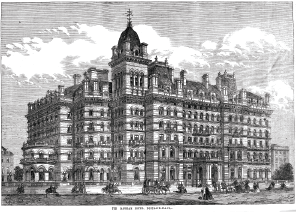
Photo Courtesy London News, Wikimedia
La Scala
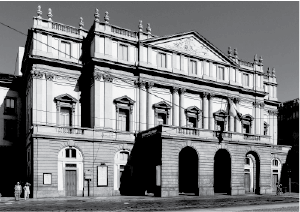
Photo Jean-Christophe Benoist Wikipedia
Imperial Opera House of Warsaw?
Having trouble finding pictures of this? It doesn't exist. See the information above on Fictitious References. Doyle used them to add depth to his narrative. If Irene Adler had been a famous singer, and there had been an Imperial Opera House of Warsaw she really would have sung there.If it makes you feel any better, they do have a Facebook page. But I wouldn't bother checking the times for their next performance.
Cabinet Photograph
Sherlock Holmes asked the King of Bohemia if the picture he was commissioned to obtain was a Cabinet.Cabinet was a style of photographic prints from 1860 to 1900. They were 4 1/2 inches by 5 1/2 inches and printed on firm card stock. You may have seen a cabinet photo from your own family history.
So why did Sherlock care? If you are looking for something it helps to know the size. Could this size be easily carried in a pocket? In a woman's purse?
And for those of you wondering about the photo above: it was from my grandparents' wedding. My grandfather wasn't a king or my grandmother a famous singer. But it was the closest thing I had.
Plumber's Smoke Rocket
Here's a doo-dad you don't hear much about anymore. This was a smoke-emitting device dropped into pipes in order to find any leaks where the smoke escaped.Just for fun, teachers or group leaders can start the discussion of this lesson, or end the discussion of the previous Sherlock Holme's lesson, with a smoke bomb. Guaranteed to get their attention - or the cost of the unit study will be fully refunded!
Language Sleuths
This story provides opportunity to look at Doyle's use of language and figures of speech.Oxymoron
Watson describes the king's dress as Barbaric Oppulence.Polyptoton
Polyptoton uses different roots of the same word for emphasis. Here are some examples:- I love and am loved by a better man than he.
- His dress was rich with a richness which would, in England, be looked up as akin to bad taste.
- "I have come incognito from Prague for the purpose of consulting you."
"Then, pray consult,” said Holmes, shutting his eyes once more. - Women are naturally secretive, and they like to do their own secreting.
- “Such paper could not be bought under half a crown a packet. It is peculiarly strong and stiff.”
“Peculiar - that is the very word,” said Holmes. “It is not an English paper at all.”
Antithesis
She has the face of the most beautiful of women, and the mind of the most resolute of men.
Buy Sherlock Holmes: The Unit Study
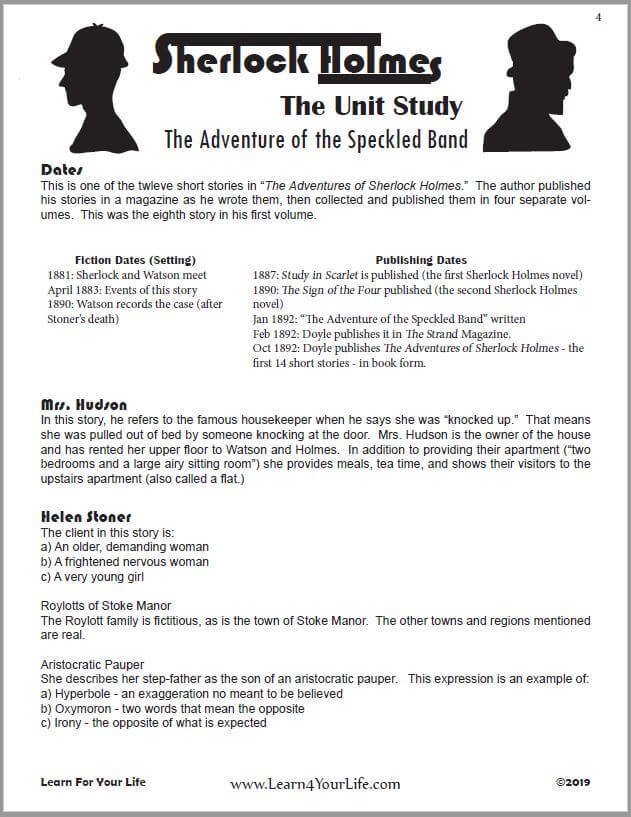
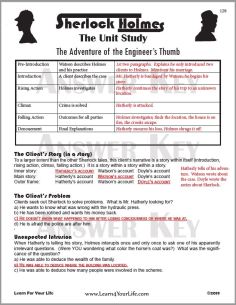
Student Guide AND Teacher's Answer Key Included
$2.99 Download - 183 pages
Eight of the most popular tales demonstrate how to investigate a detective story.
![]()
Sherlock Holmes Pages
A catalog of our pages on Sherlock Holmes.


About Our Site
Hands-On Learning







